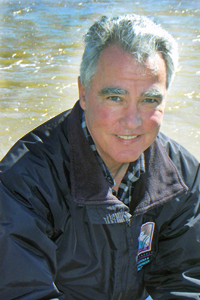Tim O'Halloran

Tim O’Halloran is a veteran of floods and water issues along Cache Creek. For the past 8 years, he has been managing the Cache Creek Watershed, making sure farms get water and the county stays safe from floods. As the general manager of the Yolo County Flood Control and Water Conservation District, Tim also works together with the Cache Creek Conservancy to help restore and maintain the creek.
What are your direct relations with the conservancy?
The role between the district that I manage and the Cache Creek Conservancy is one of a partnership. The Conservancy is here mostly for educational purposes. We cooperate, we donate, and we participate in Cache Creek cleanup days and other things. The previous manager of the District sits on the current Board of Directors of the Conservancy, so we’ve always had a good and cooperative partnership with them.
What’s the most fun aspect of your help?
Well, the one I really enjoy the most is not exactly educational; it’s the Cache Creek Cleanup Day which happens every year. I personally come out with my wife and we pick up trash along the creek—it’s under the leadership of the Conservancy. Other than that, we participate on committees [set by] the Cache Creek Resource Management Plan (CCRMP), which Yolo County is in charge of. The Conservancy and the District and the aggregate industry all participate in making that a healthy plan, a livable plan that works towards restoring the native vegetation. We participate both financially and with equipment on the invasive species program. The CCRMP’s jurisdiction goes from the Capay Dam—which is about 9 miles upstream of here—down to where Cache Creek crosses highway 5, at the township of Yolo. Our jurisdiction of course extends from the top of the system to the bottom, but within that area the Conservancy has a done a great job of tamarisk and arundo removal.
In addition to your professional life, what do you personally enjoy about this project?
Well, I’m a citizen of Woodland. I’ve been here for 8 years. In a sense, I’m still a newcomer but my position of course puts me in a leadership position, so I get involved with a lot of people. On a personal basis, I enjoy the whole stewardship ethic. You know, it’s hard to separate my personal vision from my professional life, but I love the idea of water working hard, benefitting a lot of different purposes, both economic, such as agriculture, and environmental, such as what’s happening out here: the stewardship of the land. I believe water needs to be made, in a modern society, to work for both to achieve a balance between the environmental and economic purposes. So I just enjoy being involved in all the issues surrounding land and water use management.
Where do you see this all going?
Well, again, we’re separate organizations with different missions. We’re definitely partners and we work on a professional as well as a personal level with the staff here. You know, it just depends on personal leadership and that sort of thing, but I see the programs getting stronger. I love how they diversified the education. When it started, it was more about the habitat but now they got into this story telling—like this interview—and painting and poetry and things of that nature. I think that the more people are aware of the beauty of the area in the creek, and the nuances and the history, the more people care about it. The more people care about it, the better it is for the area, for the system.
Are there any pressing agenda items you want to talk about at all?
We all work against a couple of challenges that are important and that’ll have to be overcome to really fulfill the vision that I think many people have for the creek—number one is funding. We’re in 2011 and, you know, the budget is a big challenge. The general economy has slowed down dramatically and that means the aggregate industry isn’t mining as much and there’s a fee that they pay to the Conservancy for every ton of gravel aggregate that they take out. So when they’re producing less, the Conservancy gets less, the county gets less. So there’s a balance between development and funding that goes on. And then kind of on a more personal and immediate scale is the trespassing and the trash that is left on the creek. There’s a big problem with the ATV (all terrain vehicle), coming down into the creek and running wild and trespassing. The District has property upstream from here and we get vandalized with our structures and things like that, though I don’t see stopping it with the National Guard. That means that the next best alternative is a good educational program which is, I think, what the Conservancy is all about.
Let me just add one more thing. I’ve said it a number of times in the interview but what really makes this special and makes it work is the partnership. Not just between the District and the Conservancy, but there’s the county, the aggregate industry, and the private landowners. They are vitally important to any success that happens on the creek. I just want to emphasize how important that is—how the conservancy and Jan Lowrey, who was the Executive Director before Lynnel (Pollock), worked with the private landowners and bridged the regulatory world versus the private property world. So I think that’s a credit to the leadership that the Conservancy has and that part of the vision is strong partnerships.
To download the audio, right click on the audio link above and scroll to "Save link as . . ." and choose the directory where you want to store the mp3. In Windows, you may have to use Control + S to select the link.